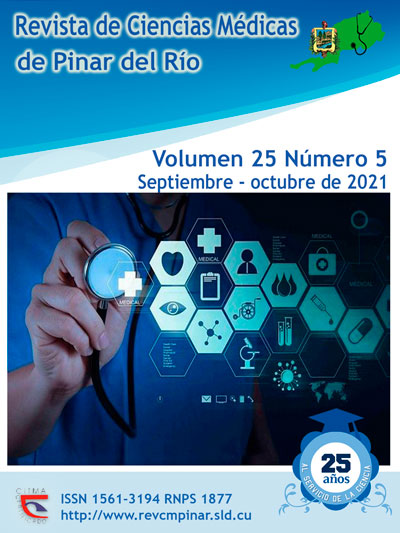A strategy for the professional training related to atrial fibrillation contextualized to the Primary Health Care settings
Keywords:
STRATEGY, TRAINING SUPPORT, ATRIAL FIBRILLATION, PROFESSIONAL TRAINING, PRIMARY HEALTH CARE.Abstract
Introduction: solving the problems of health that influence on the population constitutes the starting point for the design of professional training, a process that makes possible the update, widening and continuous improvement of knowledge, including the basic and specialized skills of healthcare professionals working in Primary Health Care level.
Objective: to design a strategy for the professional training related to atrial fibrillation contextualized to the Primary Health Care settings at Luis Augusto Turcios Lima University Polyclinic, Pinar del Rio.
Methods: the research was supported on the Dialectic-Materialistic approach which allowed deepening on the knowledge of the process and its interrelation in the historical and social conditions of postgraduate education for the Comprehensive Medicine Specialists. Theoretical methods were mainly used, such as the documentary analysis, historical-logical, modeling and the criteria of experts.
Results: the strategy for professional training related to atrial fibrillation contextualized to the Primary Health Care settings was presented and based on theoretical and empirical derivations of the research process and from the foundations supported on the different areas of knowledge, the structure, characteristics, components and relations toward the process in study and its theoretical validation.
Conclusions: the strategy for the professional training related to atrial fibrillation contextualized to the Primary Health Care setting, defined the purposes for the achievement of an efficient performance along with the transformation of the reality in the healthcare area of Luis Augusto Turcios Lima University Polyclinic, Pinar del Rio.
Downloads
References
1. Ulloa Alfonso A. Superación profesional en la atención primaria de salud [Tesis Doctoral]. La Habana: Editorial Universitaria. 2017 [citada 31/1/2021]. Disponible http://cict.umcc.cu/repositorio/tesis/Tesis%20de%20Doctorado/Ciencias%20Pedag%C3%B3gicas/2016/
2. Añorga J. La Educación Avanzada y el mejoramiento profesional y humano [Tesis doctoral]. 2014. La Habana: Universidad Pedagógica Enrique José. [aprox. 14 p.]. Disponible en: https://www.redalyc.org/pdf/3606/360634165003.pdf
3. Sánchez Rodríguez Y, Herrera Miranda G L, Páez Bejerano L R, García Seruto M, Carmona Domínguez D. Regularidades del proceso de superación profesional. Educ Med Super [Internet]. 2018 Jun [citado 31/1/2021]; 32(2): [aprox. 10 p.]. Disponible en: http://scielo.sld.cu/scielo.php?script=sci_arttext&pid=S0864-21412018000200015&lng=es
4. Ochoa-González M, Borroto-Pérez M. Estrategia de superación profesional para fortalecer la formación ambiental. Rev Educación y Sociedad [Internet]. 2015 may-ago [citada 10/2/2021]; 13(2): [aprox. 13 p.]. Disponible en: http://revistas.unica.cu/index.php/edusoc/article/view/126/_2
5. Reyes Sanamé F A, Pérez Álvarez M L, Alfonso Figueredo E, Núñez Molina B, Jiménez Rodríguez K. Fibrilación auricular. Panorámica sobre un tema actualizado. CCM [Internet]. 2018 Dic [citado 31/1/2021]; 22(4): 695-718. Disponible en: http://scielo.sld.cu/scielo.php?script=sci_arttext&pid=S1560-43812018000400014&lng=es.
6. Collazo Rodríguez P M, Rodríguez LD, Pérez Martín O, Cruz Cardentey M, Mengana Betancourt A. La epidemiología de la fibrilación auricular después de 390 años. [Internet]. 2019 Jun [citado 10/2/2021]; 23(2): 571-584. Disponible en: http://scielo.sld.cu/scielo.php?script=sci_arttext&pid=S1560-43812019000200571&lng=es
7. Sociedad Española de Cardiología. Proceso fibrilación auricular. Estándar de Calidad. SEC. [Internet]. 2018 [citado 10/2/2021]. Disponible en: https://secardiologia.es/images/SEC-Excelente/Proceso_FA_Final.doc.pdf
8. Gómez Peña L. Fibrilación atrial sintomática: modelo clínico-predictivo [Tesis doctoral]. Tesis en opción al grado científico de Doctor en Ciencias Médicas. Holguín [Internet]. 2012. [citado 10/2/2021]. Disponible en: http://tesis.sld.cu/FileStorage/000188-2B5E-gomez%20pe%C3%B1a.pdf
9. Hidalgo Mederos R, Valcárcel Izquierdo N, Menéndez González M, Arenas Gutiérrez R, Rabí Benavides RM, Álvarez Márquez R. Estrategia de Superación Profesional sobre cocientes enzimáticos como medio diagnóstico del daño hepático. Revista Cubana de Tecnología de la Salud [Internet]. 2019 [citado 10/2/2021]; 10(2): [aprox. 12 p.]. Disponible en: http://www.revtecnologia.sld.cu/index.php/tec/article/view/1467
10. Benussi S, Kotecha D, Ahlsson A, Atar D, Casadei B, Castellá M, et-al. Guía ESC 2016 sobre el diagnóstico y tratamiento de la fibrilación auricular, desarrollada en colaboración con la EACTS. Rev Esp Cardiol [Internet]. 2017[citado 10/2/2021]; 70(1): e1-e84. Disponible en:
https://www.sciencedirect.com/science/article/pii/S0300893216306625
11. Guerra García D, Valladares Carvajal F, Bernal Valladares EJ, Díaz Quiñones JA. Factores de riesgo asociados a ictus cardioembólico en pacientes con fibrilación auricular no valvular. Revista Finlay [Internet]. 2018 feb [citado 10/2/2021]; 8(1): [aprox. 9 p.]. Disponible en: http://scielo.sld.cu/pdf/rf/v8n1/rf02108.pdf.
12. Domínguez Sánchez Migallón P. Algoritmo para la atención integral al paciente con fibrilación auricular. Med Gen Fam[Internet]. 2019 [citado 10/2/2021]; 8(6): 256-261 Disponible en: http://mgyf.org/algoritmo-para-la-atencion-integral-al-paciente-con-fibrilacion-auricular/
13. Soto-Becerra R, Zafra-Tanaka JH, Goicochea-Lugo S, Alarcon-Ruiz CA, Pacheco-Barrios K, Taype-Rondan A, et - al. Guía de práctica clínica para el manejo de pacientes con fibrilación auricular en el Seguro Social del Perú (EsSalud). An. Fac. med. [Internet]. 2019 Abr [citado 10/2/2021]; 80(2): 250-263. Disponible en: http://www.scielo.org.pe/scielo.php?script=sci_arttext&pid=S1025-55832019000200021
14. Ramos Hernández R, Díaz AA, Valcárcel Izquierdo N, Ramírez Hernández BM. Las competencias profesionales específicas en la formación de los especialistas en Medicina General Integral. Educ Med Super [Internet]. 2018 [citado 10/2/2021]; 32(1): [aprox. 10 p.]. Disponible en: http://www.ems.sld.cu/index.php/ems/article/view/1188/614
Downloads
Published
How to Cite
Issue
Section
License
Authors who have publications with this journal agree to the following terms: Authors will retain their copyrights and grant the journal the right of first publication of their work, which will be publication of their work, which will be simultaneously subject to the Creative Commons Attribution License (CC-BY-NC 4.0) that allows third parties to share the work as long as its author and first publication in this journal are indicated.
Authors may adopt other non-exclusive license agreements for distribution of the published version of the work (e.g.: deposit it in an institutional telematic archive or publish it in a volume). Likewise, and according to the recommendations of the Medical Sciences Editorial (ECIMED), authors must declare in each article their contribution according to the CRediT taxonomy (contributor roles). This taxonomy includes 14 roles, which can be used to represent the tasks typically performed by contributors in scientific academic production. It should be consulted in monograph) whenever initial publication in this journal is indicated. Authors are allowed and encouraged to disseminate their work through the Internet (e.g., in institutional telematic archives or on their web page) before and during the submission process, which may produce interesting exchanges and increase citations of the published work. (See The effect of open access). https://casrai.org/credit/



